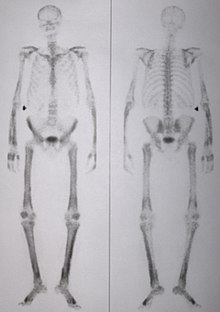Hypertrophic osteoarthropathy
| Hypertrophic osteoarthropathy | |
|---|---|
| Other names | Hypertrophic pulmonary osteoarthropathy, Bamberger–Marie syndrome,[1] osteoarthropathia hypertrophicans[2] |
 | |
| Bonescan of a person with hypertrophic osteoarthropathy | |
| Specialty | Rheumatology |
Hypertrophic osteoarthropathy is a medical condition combining clubbing and periostitis of the small hand joints, especially the distal interphalangeal joints and the metacarpophalangeal joints. Distal expansion of the long bones as well as painful, swollen joints[3] and synovial villous proliferation are often seen. The condition may occur alone (primary), or it may be secondary to diseases like lung cancer. Among patients with lung cancer, it is most associated with adenocarcinoma and least associated with small cell lung cancer. These patients often get clubbing and increased bone deposition on long bones. Their presenting signs and symptoms are sometimes only clubbing and painful ankles.[citation needed]
Cause
Hypertrophic osteoarthropathy is one of many distant effect disorders due to cancer, with lung cancer being the most common cause but also occurring with ovarian or adrenal malignancies. A distant effect disorder, or a
Diagnosis
People with hypertrophic osteoarthropathy may have bone scans showing parallel lines of activity along the cortex of the shafts and ends of tibiae, femurs and radii; especially around the knees, ankles and wrists. This activity may decrease after treatment of the underlying cause.[4]
Treatment
Non-steroidal anti-inflammatory drugs (NSAIDs) can give significant relief of the symptoms. Treatment of lung cancer or other causes of hypertrophic osteoarthropathy results in regression of symptoms for some patients.[citation needed]
Etymology
The eponymous 'Bamberger–Marie syndrome' is named for Austrian internist Eugen von Bamberger and French neurologist Pierre Marie.[5][6][7]
See also
References
- S2CID 21226683.
- S2CID 34009164. Archived from the originalon 1999-08-23.
- ISBN 978-1437727883.
- ^ Essentials of Nuclear Medicine Imaging (Sixth Edition), 2012
- Who Named It?
- ^ von Bamberger E (1889). "Veränderungen der Röhrenknochen bei Bronchiektasie". Wiener klinische Wochenschrift. 2: 226.
- ^ Marie P (1890). "De l'osteo-arthropathie hypertrophiante pneumique". Rév Med, Paris. 10: 1–36.
